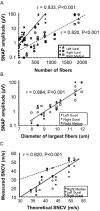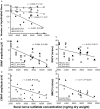Sulfatide levels correlate with severity of neuropathy in metachromatic leukodystrophy
- PMID: 26000324
- PMCID: PMC4435706
- DOI: 10.1002/acn3.193
Sulfatide levels correlate with severity of neuropathy in metachromatic leukodystrophy
Abstract
Objective: Metachromatic leukodystrophy (MLD) is an autosomal recessive lysosomal storage disorder due to deficient activity of arylsulfatase A (ASA) that causes accumulation of sulfatide and lysosulfatide. The disorder is associated with demyelination and axonal loss in the central and peripheral nervous systems. The late infantile form has an early-onset, rapidly progressive course with severe sensorimotor dysfunction. The relationship between the degree of nerve damage and (lyso)sulfatide accumulation is, however, not established.
Methods: In 13 children aged 2-5 years with severe motor impairment, markedly elevated cerebrospinal fluid (CSF) and sural nerve sulfatide and lysosulfatide levels, genotype, ASA mRNA levels, residual ASA, and protein cross-reactive immunological material (CRIM) confirmed the diagnosis. We studied the relationship between (lyso)sulfatide levels and (1) the clinical deficit in gross motor function (GMFM-88), (2) median and peroneal nerve motor and median and sural nerve sensory conduction studies (NCS), (3) median and tibial nerve somatosensory evoked potentials (SSEPs), (4) sural nerve histopathology, and (5) brain MR spectroscopy.
Results: Eleven patients had a sensory-motor demyelinating neuropathy on electrophysiological testing, whereas two patients had normal studies. Sural nerve and CSF (lyso)sulfatide levels strongly correlated with abnormalities in electrophysiological parameters and large myelinated fiber loss in the sural nerve, but there were no associations between (lyso)sulfatide levels and measures of central nervous system (CNS) involvement (GMFM-88 score, SSEP, and MR spectroscopy).
Interpretation: Nerve and CSF sulfatide and lysosulfatide accumulation provides a marker of disease severity in the PNS only; it does not reflect the extent of CNS involvement by the disease process. The magnitude of the biochemical disturbance produces a continuously graded spectrum of impairments in neurophysiological function and sural nerve histopathology.
Figures







References
-
- Gieselmann V. Metachromatic leukodystrophy: genetics, pathogenesis and therapeutic options. Acta Paediatr Suppl. 2008;97:15–21. - PubMed
-
- Biffi A, Cesani M, Fumagalli F, et al. Metachromatic leukodystrophy – mutation analysis provides further evidence of genotype-phenotype correlation. Clin Genet. 2008;74:349–357. - PubMed
-
- Miller RG, Gutmann L, Lewis RA, Sumner AJ. Acquired versus familial demyelinative neuropathies in children. Muscle Nerve. 1985;8:205–210. - PubMed
-
- Zafeiriou DI, Kontopoulos EE, Michelakakis HM, et al. Neurophysiology and MRI in late-infantile metachromatic leukodystrophy. Pediatr Neurol. 1999;21:843–846. - PubMed
-
- Toda K, Kobayashi T, Goto I, et al. Lysosulfatide (sulfogalactosylsphingosine) accumulation in tissues from patients with metachromatic leukodystrophy. J Neurochem. 1990;55:1585–1591. - PubMed
LinkOut - more resources
Full Text Sources
Other Literature Sources
Medical

